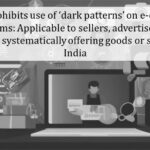The Department of Consumer Affairs has requested comments/suggestions on the Draft Guidelines on Prevention and Regulation of Dark Patterns (“Draft Guidelines”) by 5th October 2023 by e-mail to js-ca@nic.in.
These Guidelines have been proposed to be applicable to sellers, advertisers and all platforms, systematically offering goods or services in India. The Draft Guidelines prohibit the engagement of Dark Patterns.
“Dark patterns” have been defined as any practices or deceptive design patterns using UI/UX (user interface/user experience) interactions on any platform; designed to mislead or trick users to do something they originally did not intend or want to do; by subverting or impairing the consumer autonomy, decision making or choice; amounting to misleading advertisement or unfair trade practice or violation of consumer rights.
Following are the examples of dark patterns as illustrated by the Draft Guidelines:
a. False Urgency – means falsely stating or implying the sense of urgency or scarcity so as to mislead a user into making an immediate purchase or take an immediate action, which may lead to a purchase.
b. Basket Sneaking – means inclusion of additional items such as products, services, payments to charity/donation at the time of checkout from a platform, without the consent of the user, such that the total amount payable by the user is more than the amount payable for the product(s) and/or service(s) chosen by the user. Provided that the addition of free samples or providing complimentary services or addition of necessary fees disclosed at the time of purchase, shall not be considered basket sneaking.
c. Confirm shaming – means using a phrase, video, audio or any other means to create a sense of fear or shame or ridicule or guilt in the mind of the user, so as to nudge the user to act in a certain way that results in the user purchasing a product or service from the platform or continuing a subscription of a service.
d. Forced Action ¬- mean forcing a user into taking an action that would require the user to buy any additional good(s) or subscribe or sign up for an unrelated service, in order to buy or subscribe to the product/service originally intended by the user.
e. Subscription Trap – means the process –
i. of making cancellation of a paid subscription impossible or a complex and lengthy process; or
ii. hiding the cancellation option for a subscription; or
iii. forcing a user to provide payment details and/or authorization for auto debits for availing a free subscription
iv. making the instructions related to cancellation of subscription ambiguous, latent, confusing, cumbersome
f. Interface interference – means a design element that manipulates the user interface in ways that (a) highlights certain specific information; and (b) obscures other relevant information relative to the other information; to misdirect a user from taking an action desired by her.
g. Bait and switch – means the practice of advertising a particular outcome based on the user’s action but deceptively serving an alternate outcome.
h. Drip pricing – means a practice where by
i. elements of prices are not revealed upfront or are revealed surreptitiously within the user experience; or
ii. revealing the price post-confirmation of purchase, i.e. charging an amount higher than the amount disclosed at the time of checkout; or
iii. a product or service is advertised as free without appropriate disclosure of the fact that the continuation of use requires in-app purchase; or
iv. a user is prevented from availing a service which is already paid for unless something additional is purchased
i. Disguised advertisement – means a practice of posing, masking advertisements as other types of content such as user generated content or new articles or false advertisements.
j. Nagging – mean a dark pattern due to which users face an overload of requests, information, options, or interruptions; unrelated to the intended purchase of goods or services, which disrupts the intended transaction.
Please refer to the hyperlink below for a detailed read.
Source: Department of Consumer Affairs





